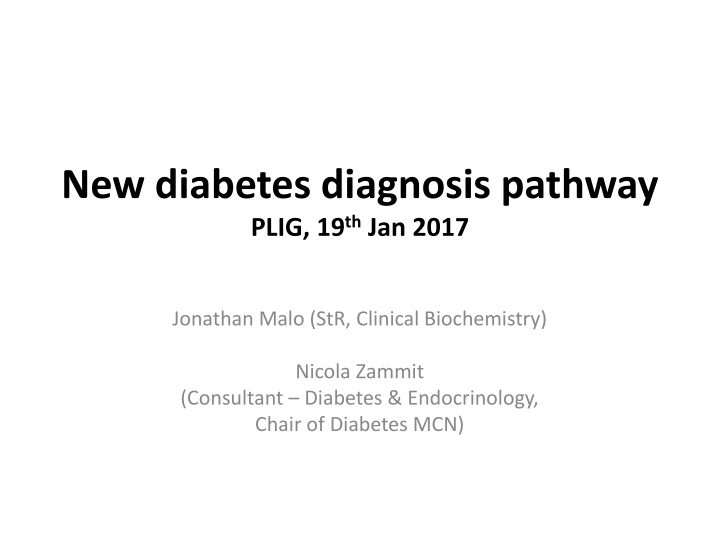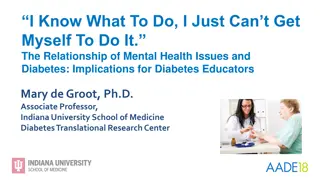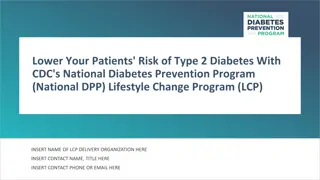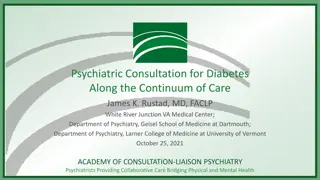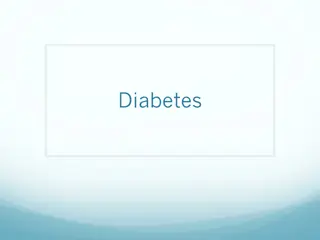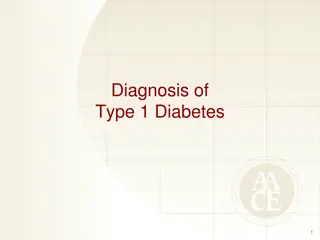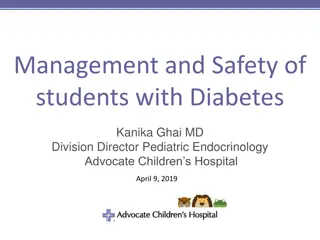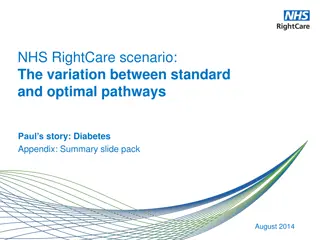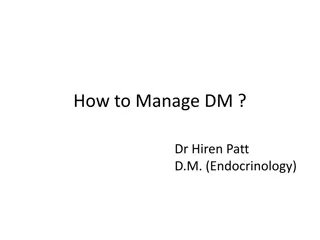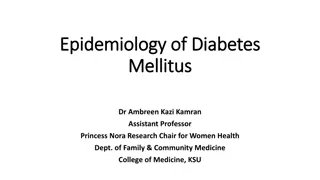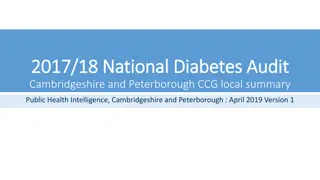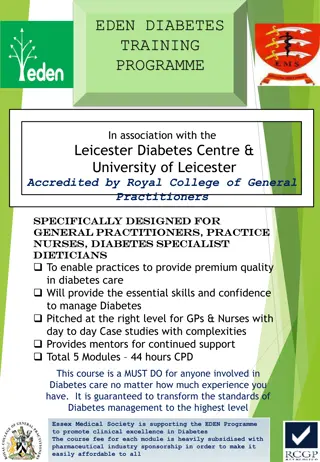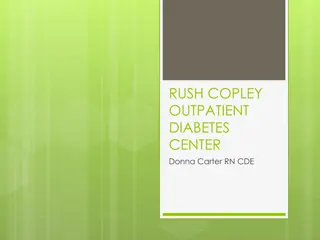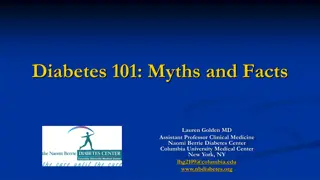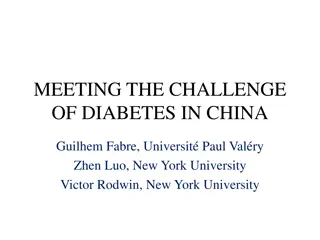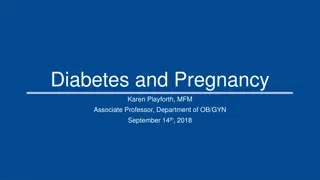New diabetes diagnosis pathway
"Discover the latest approach in diabetes diagnosis created by Jonathan Malo and Nicola Zammit. Stay informed on the innovative pathway for diagnosing diabetes. Gain valuable insights from experts in clinical biochemistry and diabetes management."
Download Presentation

Please find below an Image/Link to download the presentation.
The content on the website is provided AS IS for your information and personal use only. It may not be sold, licensed, or shared on other websites without obtaining consent from the author.If you encounter any issues during the download, it is possible that the publisher has removed the file from their server.
You are allowed to download the files provided on this website for personal or commercial use, subject to the condition that they are used lawfully. All files are the property of their respective owners.
The content on the website is provided AS IS for your information and personal use only. It may not be sold, licensed, or shared on other websites without obtaining consent from the author.
E N D
Presentation Transcript
New diabetes diagnosis pathway PLIG, 19thJan 2017 Jonathan Malo (StR, Clinical Biochemistry) Nicola Zammit (Consultant Diabetes & Endocrinology, Chair of Diabetes MCN)
New local pathway: Diagnosis of Diabetes in Asymptomatic adults Piloted in 2015 in SE Edinburgh GP practices Lothian-wide implementation from Oct 2016 Incorporates HbA1c in recognition of: expert consensus on use of HbA1c for diagnosis principal means for guiding diabetes management relative ease / convenience compared to fasting glucose, or OGTT However glucose remains 1st line test: HbA1c 4.00 Glucose 0.70 number of primary care requests imply an unacceptable increase in cost & workload from switching to HbA1c as 1st line test Glucose 194,518 HbA1c 67,994 2016 primary care:
Diagnosis of diabetes mellitus in ASYMPTOMATIC adults (If elderly, frail and asymptomatic, please consider whether screening is appropriate.) random glucose 11.1 mmol/L fasting glucose 7.0 mmol/L INITIAL lab glucose (random OR fasting) random glucose fasting glucose 7.8 11.0 mmol/L 6.1 6.9 mmol/L
Diagnosis of diabetes mellitus in ASYMPTOMATIC adults (If elderly, frail and asymptomatic, please consider whether screening is appropriate.) Take together on separate day Determine whether at risk / diabetic (see fasting glucose & HbA1C ranges below) random glucose 11.1 mmol/L fasting glucose (Omit HbA1C if not suitable. See below.*) & HbA1C fasting glucose 7.0 mmol/L INITIAL lab glucose (random OR fasting) random glucose fasting glucose 7.8 11.0 mmol/L 6.1 6.9 mmol/L
Diagnosis of diabetes mellitus in ASYMPTOMATIC adults (If elderly, frail and asymptomatic, please consider whether screening is appropriate.) Take together on separate day Determine whether at risk / diabetic (see fasting glucose & HbA1C ranges below) random glucose 11.1 mmol/L fasting glucose (Omit HbA1C if not suitable. See below.*) & HbA1C fasting glucose 7.0 mmol/L INITIAL lab glucose (random OR fasting) random glucose fasting glucose 7.8 11.0 mmol/L 6.1 6.9 mmol/L * Not suitable for HbA1C 1) Rapid onset of diabetes a. Suspected T1DM see symptomatic patient flowchart b. Drug-induced: steroids, anti-psychotics, immuno- suppressants a fasting glucose may not be sufficient. c.Pancreatic disease 2) Conditions affecting Hb turnover / HbA1C assay a. Haemoglobinopathy b. Anaemia (especially haemolytic) c. Severe blood loss, Blood transfusion d. Splenomegaly / Splenectomy e. Renal dialysis +/- erythropoitein f. Anti-retrovirals, ribavarin, dapsone 3) Children * Pregnancy- see local guidelines for screening/referral a. HbA1C may be used to screen for pre-existing diabetes, but should NOT be used to screen for Gestational Diabetes (GDM) b. Note that the OGTT for GDM uses lower cut-offs: Fasting glucose 5.1 mmol/L, 2-hr glucose 8.5 mmol/L Seek diabetes team advice
Diagnosis of diabetes mellitus in ASYMPTOMATIC adults (If elderly, frail and asymptomatic, please consider whether screening is appropriate.) Take together on separate day Determine whether at risk / diabetic (see fasting glucose & HbA1C ranges below) random glucose 11.1 mmol/L fasting glucose (Omit HbA1C if not suitable. See below.*) & HbA1C fasting glucose 7.0 mmol/L INITIAL lab glucose (random OR fasting) random glucose fasting glucose 7.8 11.0 mmol/L 6.1 6.9 mmol/L suitable for HbA1C? * YES NO (repeat blood test on a separate day) OGTT HbA1C (75 g)
Diagnosis of diabetes mellitus in ASYMPTOMATIC adults (If elderly, frail and asymptomatic, please consider whether screening is appropriate.) Take together on separate day Determine whether at risk / diabetic (see fasting glucose & HbA1C ranges below) random glucose 11.1 mmol/L fasting glucose (Omit HbA1C if not suitable. See below.*) & HbA1C fasting glucose 7.0 mmol/L INITIAL lab glucose (random OR fasting) random glucose fasting glucose 7.8 11.0 mmol/L 6.1 6.9 mmol/L suitable for HbA1C? * YES NO (repeat blood test on a separate day) OGTT HbA1C (75 g) not not diabetic diabetic fasting glucose mmol/L 41 6.0 mmol/mol AND 2-hr glucose mmol/L 7.7
Diagnosis of diabetes mellitus in ASYMPTOMATIC adults (If elderly, frail and asymptomatic, please consider whether screening is appropriate.) Take together on separate day Determine whether at risk / diabetic (see fasting glucose & HbA1C ranges below) random glucose 11.1 mmol/L fasting glucose (Omit HbA1C if not suitable. See below.*) & HbA1C fasting glucose 7.0 mmol/L INITIAL lab glucose (random OR fasting) random glucose fasting glucose 7.8 11.0 mmol/L 6.1 6.9 mmol/L suitable for HbA1C? * YES NO (repeat blood test on a separate day) OGTT HbA1C (75 g) not at risk of DM not at risk of DM diabetic diabetic 42 47 mmol/mol fasting glucose mmol/L 41 6.0 6.1 6.9 (IFG) mmol/mol AND OR 2-hr glucose mmol/L 7.7 7.8 11.0 (IGT)
Diagnosis of diabetes mellitus in ASYMPTOMATIC adults (If elderly, frail and asymptomatic, please consider whether screening is appropriate.) Take together on separate day Determine whether at risk / diabetic (see fasting glucose & HbA1C ranges below) random glucose 11.1 mmol/L fasting glucose (Omit HbA1C if not suitable. See below.*) & HbA1C fasting glucose 7.0 mmol/L INITIAL lab glucose (random OR fasting) random glucose fasting glucose 7.8 11.0 mmol/L 6.1 6.9 mmol/L suitable for HbA1C? * YES NO (repeat blood test on a separate day) OGTT HbA1C (75 g) not at risk of DM not at risk of DM diabetes diabetes diabetic diabetic 42 47 mmol/mol fasting glucose mmol/L 41 48 6.0 7.0 6.1 6.9 (IFG) mmol/mol mmol/mol AND OR OR 2-hr glucose mmol/L 7.7 11.1 7.8 11.0 (IGT)
Diagnosis of diabetes mellitus in ASYMPTOMATIC adults (If elderly, frail and asymptomatic, please consider whether screening is appropriate.) Take together on separate day Determine whether at risk / diabetic (see fasting glucose & HbA1C ranges below) random glucose 11.1 mmol/L fasting glucose (Omit HbA1C if not suitable. See below.*) & HbA1C fasting glucose 7.0 mmol/L INITIAL lab glucose (random OR fasting) random glucose fasting glucose 7.8 11.0 mmol/L 6.1 6.9 mmol/L suitable for HbA1C? * At risk of DM groups include: IFG = impaired fasting glucose IGT = impaired glucose tolerance HbA1C 42-47 mmol/mol YES NO (repeat blood test on a separate day) OGTT HbA1C (75 g) Consider lifestyle advice & annual HbA1C check for these groups not at risk of DM not at risk of DM diabetes diabetes diabetic diabetic 42 47 mmol/mol fasting glucose mmol/L 41 48 6.0 7.0 6.1 6.9 (IFG) mmol/mol mmol/mol AND OR OR 2-hr glucose mmol/L 7.7 11.1 7.8 11.0 (IGT)
Diagnosis of diabetes mellitus in ASYMPTOMATIC adults (If elderly, frail and asymptomatic, please consider whether screening is appropriate.) Take together on separate day Determine whether at risk / diabetic (see fasting glucose & HbA1C ranges below) random glucose 11.1 mmol/L fasting glucose (Omit HbA1C if not suitable. See below.*) & HbA1C fasting glucose 7.0 mmol/L INITIAL lab glucose (random OR fasting) random glucose fasting glucose 7.8 11.0 mmol/L Where there is diagnostic uncertainty consider contacting diabetes email advice service 6.1 6.9 mmol/L suitable for HbA1C? * At risk of DM groups include: IFG = impaired fasting glucose IGT = impaired glucose tolerance HbA1C 42-47 mmol/mol YES NO (repeat blood test on a separate day) OGTT HbA1C (75 g) Consider lifestyle advice & annual HbA1C check for these groups not at risk of DM not at risk of DM diabetes diabetes diabetic diabetic 42 47 mmol/mol fasting glucose mmol/L 41 48 6.0 7.0 6.1 6.9 (IFG) mmol/mol mmol/mol AND OR OR 2-hr glucose mmol/L 7.7 11.1 7.8 11.0 (IGT)
New pathway Old pathway
New pathway Old pathway
New pathway Old pathway 1 2 1 3 2
Trends in HbA1c & glucose testing for Lothian Yanhong Wang (SCI-Diabetes), Carol Thomson (Labs IT) Pilot of new pathway in 2015 Compared 6 months pre-pilot vs. 6 months pilot 15 GP practices in SE Edinburgh (~10% of all 1o care testing) Pan-Lothian testing over same period Pilot study results: 2 x 6 month periods 2nd 6mth Pre-pilot Pilot % change 6 mth % change HbA1c 30,035 31,964 +6.4% HbA1c 3,481 3,429 -1.5% Glucose 100,065 101,803 +1.7% Glucose 10,031 9,797 -2.3% OGTT 186 151 -18.8% Apparently neutral effect on HbA1c, glucose requesting (reassuring for lab) OGTT numbers small ?significant fall Feedback on use of pathway generally positive Post pilot Pathway discussed with clinical leads for diabetes Distributed Lothian-wide as a recommendation in Oct 2016
Trends in HbA1c & glucose testing for Lothian Any change since introduction of pathway in Oct 2016? 6500 HbA1c tests (per month) past 2 years 6000 5500 5000 * * 4500 * festive dip Probably too early to draw any conclusions . 4000 Oct 16: new pathway starts 3500 Jan 15 Jan 16 3000 1 2 3 4 5 6 7 8 9 10 11 12 13 14 15 16 17 18 19 20 21 22 23 24 Oct Nov Dec Since Oct 2016, possible to distinguish HbA1c requested for diagnosis vs. monitoring: % diagnostic HbA1c 31% 32% 40% We will continue to follow these ratios over the coming year
Trends in HbA1c & glucose testing for Lothian Long view: what is the trend in HbA1c requesting? % change requesting levels: Oct 2013 - Nov 2016 20 Jan 2015 Nov 2016 Jan 2014 Jan 2016 15 10 HbA1c 5 HbA1c + glucose 0 1 3 5 7 9 11 13 15 17 19 21 Glucose 23 25 27 29 31 33 35 37 -5 HbA1c test numbers are rising Glucose numbers are static/falling Possible causes: - rising diabetic population (hence more HbA1c monitoring) - increasing use of HbA1c in diagnosis monitoring Both?
Trends in HbA1c & glucose testing for Lothian NHS Lothian diabetic population 42000 40000 38000 18% increase over past 5 years 36000 34000 32000 2011 2012 2013 2014 2015 2016 Ratio of HbA1c numbers : diabetic prevalence 2.5 2.4 No of HbA1c per diabetic popn slight increase 2.3 2.2 2.1 2 2011 2012 2013 2014 2015 2016
Straw poll new diabetes diagnostic pathway How many of you - - are aware of new diagnostic pathway? have used it? - - have had problems with it? prefer the previous glucose-only pathway? How many using HbA1c for diagnosis before the new pathway?
Other local diagnostic guidelines Lothian pathway is very similar to (independently drawn-up) guidelines in: Glasgow & Greater Clyde Lanarkshire Other pathways (some parts of England & Wales): HbA1c as 1st line test OR Risk scoring* as 1st line screening step, then HbA1c for high risk individuals (Can be conducted opportunistically by HCP or individual, or via electronic health record search.) *age, sex, ethnicity, fam hx of DM, waist size, BMI, HTN
Diagnosis of diabetes mellitus in ASYMPTOMATIC adults (If elderly, frail and asymptomatic, please consider whether screening is appropriate.) Take together on separate day Determine whether at risk / diabetic (see fasting glucose & HbA1C ranges below) random glucose / L L 1 1 1 1 . . 1 1 m mm mo o l l / fasting glucose (Omit HbA1C if not suitable. See below.*) & HbA1C fasting glucose / L L 7 7 . . 0 0 m mm mo o l l / INITIAL lab glucose (random OR fasting) random glucose fasting glucose 7.8 11.0 mmol/L Where there is diagnostic uncertainty consider contacting diabetes email advice service 6.1 6.9 mmol/L suitable for HbA1C? * YES NO (repeat blood test on a separate day) OGTT HbA1C (75 g) not at risk of DM not at risk of DM diabetes diabetes diabetic diabetic 4 4 1 1 mmol/mol 42 mmol/mol 47 8 fasting glucose mmol/L 4 4 8 0 0 . 0 0 6 6. . 7 7 . 6.1 6.9 (IFG) mmol/mol AND OR OR 2-hr glucose mmol/L 7 7 1 . . 1 1 * Not suitable for HbA1C 1) Rapid onset of diabetes a. Suspected T1DM see symptomatic patient flowchart b. Drug-induced: steroids, anti-psychotics, immuno- suppressants a fasting glucose may not be sufficient. c.Pancreatic disease 2) Conditions affecting Hb turnover / HbA1C assay a. Haemoglobinopathy b. Anaemia (especially haemolytic) c. Severe blood loss, Blood transfusion d. Splenomegaly / Splenectomy e. Renal dialysis +/- erythropoitein f. Anti-retrovirals, ribavarin, dapsone 3) Children * Pregnancy - see local guidelines for screening/referral a. HbA1C may be used to screen for pre-existing diabetes, but should NOT be used to screen for Gestational Diabetes (GDM) b. Note that the OGTT for GDM uses lower cut-offs: Fasting glucose 5. 1 mmol/L, 2-hr glucose 8 . 7 7 . . 1 1 1 7.8 11.0 (IGT) Seek diabetes team advice At risk of DM groups include: IFG = impaired fasting glucose IGT = impaired glucose tolerance HbA1C 42-47 mmol/mol Consider lifestyle advice & annual HbA1C check for these groups Diagnosis must be based on laboratory glucose measurements 5 mmol/L
